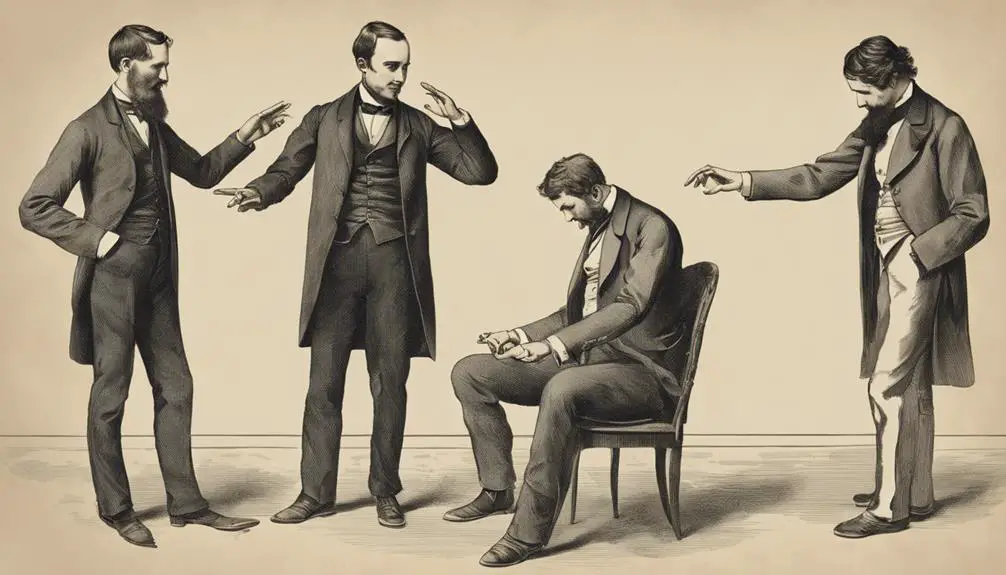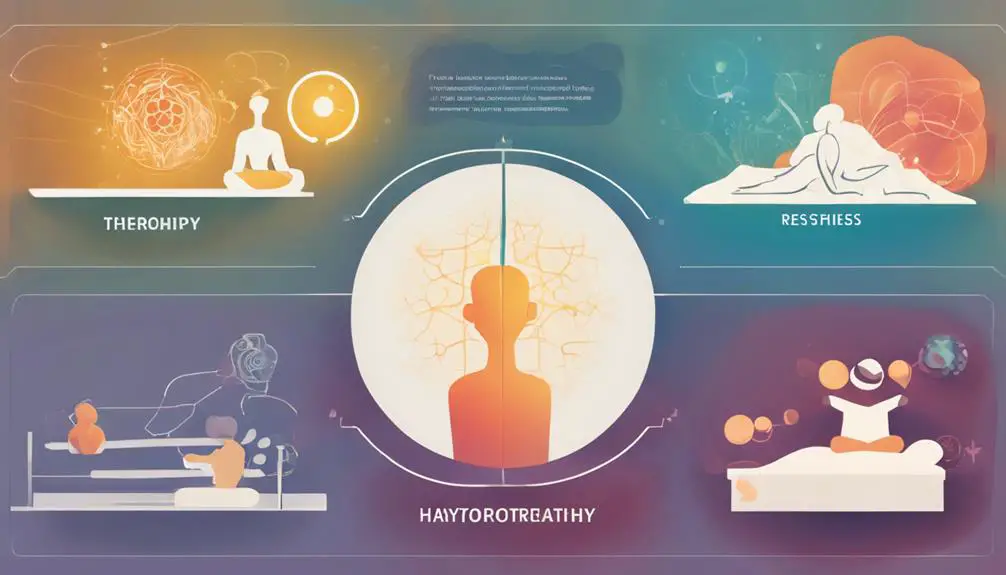Hypnosis
Evolution of Hypnotherapy Techniques: A Comprehensive Guide
The evolution of hypnotherapy techniques traces back to ancient practices and key figures such as Franz Mesmer, James Braid, and Sigmund Freud. Mesmer's influence with animal magnetism and Freud's contributions to psychoanalysis shaped modern hypnotherapy. Techniques today involve cognitive restructuring, tailored suggestions, and mindfulness for emotional regulation. Hypnosis in the 19th century paved the way for contemporary trends emphasizing verbal cues, imagery, and reframing beliefs. This comprehensive guide showcases the historical progression and insightful advancements in hypnotherapy methods, from early mesmerism theories to the sophisticated approaches used in modern practice.
Early Hypnotic Practices

Historical records indicate that early hypnotic practices were sporadically documented across different cultures, with varying degrees of effectiveness and understanding.
One significant figure in the history of hypnosis is Franz Mesmer, whose work laid the foundation for modern hypnotherapy. Mesmer's legacy, rooted in spiritual beliefs and the concept of 'animal magnetism,' influenced the development of hypnotic techniques that are still used today.
Moreover, before Freud's psychoanalytic theories gained prominence, hypnosis was already being explored for its therapeutic applications. Pre-Freudian influences on hypnotherapy can be traced back to the work of physicians such as James Braid and John Elliotson. They began to use hypnosis as a tool for treating various medical and psychological conditions, paving the way for the integration of hypnosis into mainstream medicine.
These early hypnotic practices, influenced by Mesmer's spiritual roots and pre-Freudian therapeutic applications, set the stage for the evolution of hypnotherapy techniques that continue to be refined and utilized in modern clinical settings.
Mesmerism and Animal Magnetism
The concept of Mesmerism and Animal Magnetism, originating from Franz Mesmer's theories, has been a subject of both historical interest and ongoing study in the field of hypnotherapy.
Mesmer believed that there was an invisible energy, which he termed 'animal magnetism,' flowing between individuals, and that disturbances in this energy flow could lead to various ailments. He used techniques such as passes of the hands or magnetic objects to rebalance this energy and induce healing. Mesmer's practices were often associated with trance states, where individuals would enter altered states of consciousness.
While Mesmerism was initially met with skepticism and controversy, it laid the foundation for modern hypnotherapy techniques. The focus on energy flow and trance states in Mesmerism parallels aspects of spiritual healing and magnetic therapy seen in various cultures throughout history.
Understanding the historical context and theoretical underpinnings of Mesmerism can provide valuable insights into the evolution of hypnotherapy practices today.
Development of Suggestion Techniques

As hypnotherapy evolved, the development of suggestion techniques played a pivotal role in shaping the field's clinical approach and efficacy. The power of suggestion, a fundamental aspect of hypnotherapy, harnesses the mind's ability to influence behavior through verbal cues and imagery.
By utilizing suggestion techniques, practitioners aim to restructure cognitive patterns, tapping into the subconscious mind to facilitate behavioral modification in clients.
Through strategic language patterns and tailored suggestions, hypnotherapists can guide individuals towards desired outcomes, such as smoking cessation, weight loss, or stress management. Cognitive restructuring techniques within hypnotherapy help individuals challenge and modify negative thought patterns, fostering a more positive mindset and behavior change.
This process involves accessing the subconscious influence to reframe beliefs and perceptions, ultimately leading to improved emotional well-being and enhanced coping strategies.
In essence, the development of suggestion techniques in hypnotherapy underscores its capacity for facilitating profound psychological shifts and empowering individuals to make lasting changes in their lives through targeted behavioral modification approaches.
Hypnosis in the 19th Century
During the 19th century, hypnosis gained significant recognition and interest as a subject of scientific inquiry and therapeutic exploration. This era was marked by the influence of figures such as Franz Mesmer, who developed the concept of animal magnetism, later known as mesmerism.
Mesmer's techniques involved inducing trance-like states in patients by using hand gestures and magnets, laying the foundation for modern hypnosis.
Mesmer's work sparked a wave of fascination with hypnosis, leading to further research and experimentation. The 19th century saw the refinement of hypnotic induction methods and the exploration of its potential applications in medicine and psychology.
Pioneering researchers like James Braid played a crucial role in demystifying hypnosis and shifting the focus towards understanding it as a natural psychological phenomenon.
Freud and Hypnotherapy

Sigmund Freud's contributions to the field of hypnotherapy revolutionized the understanding and application of psychoanalysis in treating various psychological disorders. Freudian influence on hypnotherapy was significant, particularly in his emphasis on subconscious exploration.
Freud initially used hypnosis in his clinical practice to help patients uncover repressed memories and unresolved conflicts buried deep within the subconscious mind. This approach laid the foundation for his development of psychoanalysis, where the exploration of the unconscious played a central role in understanding and treating mental health issues.
Freud's work with hypnotherapy paved the way for modern psychotherapy techniques, influencing the importance of delving into the hidden layers of the mind to address underlying issues. While Freud eventually moved away from hypnosis in favor of free association and dream analysis, his early work with hypnotherapy left a lasting impact on the field of psychology.
Today, Freud's legacy continues to shape the practice of hypnotherapy, underscoring the significance of subconscious exploration in therapeutic interventions.
Modern Hypnotherapy Approaches
Building upon the foundational work of Sigmund Freud in hypnotherapy, contemporary approaches in the field have evolved to incorporate a diverse range of techniques tailored to individual client needs and therapeutic goals.
Neuro-linguistic programming (NLP) is one such approach that focuses on the connection between neurological processes, language, and behavioral patterns. By utilizing NLP techniques during hypnotherapy sessions, therapists can help clients reframe their thoughts and behaviors more effectively.
Mindfulness has also become a prevalent technique in modern hypnotherapy. By incorporating mindfulness practices into sessions, clients are encouraged to stay present and aware of their thoughts and emotions, promoting a deeper sense of relaxation and self-awareness.
Additionally, cognitive-behavioral therapy (CBT) techniques are frequently integrated into hypnotherapy sessions to target specific issues such as phobias, anxiety, or addiction. This evidence-based approach helps clients identify and change negative thought patterns and behaviors.
Virtual reality is another innovative tool being used in modern hypnotherapy. By immersing clients in virtual environments, therapists can create controlled and tailored scenarios to help individuals confront and overcome their fears or traumas in a safe and supportive setting.
Contemporary Trends in Hypnosis

Contemporary trends in hypnosis reflect a shift towards incorporating innovative technologies and evidence-based therapeutic approaches to enhance client outcomes and address a diverse array of psychological issues. Neuroscientific research has played a crucial role in understanding the underlying mechanisms of hypnosis, leading to more targeted and effective interventions.
Hypnotic regression, a technique that involves guiding clients back to past events or memories, is gaining traction as a tool for uncovering and resolving deep-seated psychological issues.
Virtual reality is being integrated into hypnotherapy sessions to create immersive environments that aid in relaxation and visualization exercises. This technology allows clients to engage more fully in the therapeutic process, enhancing the overall effectiveness of hypnosis.
Additionally, mindfulness integration has become a prevalent trend in hypnotherapy, combining the benefits of mindfulness practices with hypnotic techniques to promote self-awareness and emotional regulation.
Frequently Asked Questions
Can Hypnotherapy Be Used to Erase Memories?
Memory manipulation through hypnotherapy to erase memories raises ethical concerns. While some studies suggest potential for memory alteration, more research is needed. Ethical guidelines must be followed to safeguard individual autonomy and well-being.
Is Self-Hypnosis Safe for Beginners?
Self-hypnosis can offer benefits such as stress reduction and self-improvement, but beginners should be cautious due to potential limitations like unintended outcomes. Utilizing reliable techniques and resources can enhance safety and effectiveness.
How Long Does It Take to See Results From Hypnotherapy?
The effectiveness of hypnotherapy in producing results varies among individuals. Patients may experience changes in a few sessions, while others might require more time. Managing patient expectations through open communication is crucial for successful outcomes.
Can Hypnotherapy Help With Physical Pain?
Hypnotherapy has shown promising results in pain management by tapping into the mind-body connection. As an alternative therapy, it may provide relief for individuals with chronic conditions. Research supports its efficacy, highlighting its potential benefits.
Are There Any Risks or Side Effects Associated With Hypnotherapy?
Hypnotherapy, when conducted by a trained professional, typically poses minimal risks. However, potential dangers may include false memories, heightened emotional responses, and temporary dizziness. Adverse reactions are rare but may occur in susceptible individuals.
Conclusion
In conclusion, the evolution of hypnotherapy techniques has seen significant advancements from early practices such as Mesmerism and Animal Magnetism to modern approaches based on suggestion and cognitive-behavioral therapy.
The influence of figures like Freud has shaped the development of hypnotherapy, while contemporary trends continue to explore new applications and effectiveness of hypnosis in various therapeutic settings.
Overall, hypnotherapy techniques have evolved over time to become a valuable tool in the field of mental health treatment.
